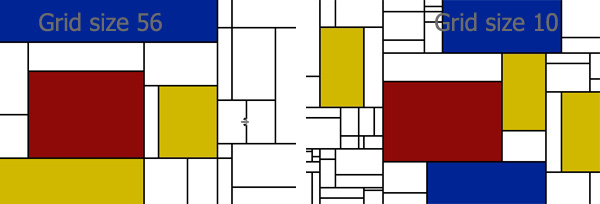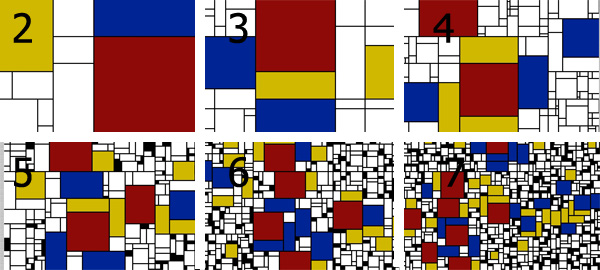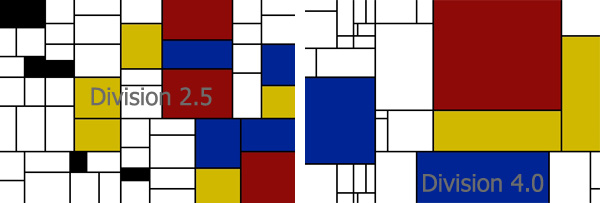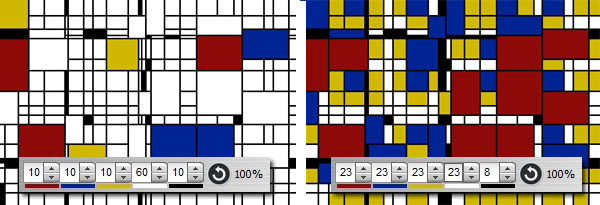 Legoaizer -
Help Legoaizer -
Help |
 Legoaizer -
Help
Legoaizer -
Help
Piet Mondriaan
Mondriaan
is a very, very special kind of function in Legoaizer. And also an odd one
because it's not really a new feature of Legoaizer, but rather a bonus from the
application development team... we like the Mondriaan paintings so much, we
wanted to make a brick version
of it. So here it is, for you. Like it or ignore it.
We like it.
What is Piet
Mondriaan?
The right question should be: who is
Piet Mondriaan. According to Wikipedia:
"Pieter Cornelis (Piet) Mondriaan, after 1906 Mondrian, 7 March 1872 – 1 February
1944), was a Dutch painter.
Mondrian was
a contributor to the De Stijl art movement and group, which was founded by
Theo van Doesburg. He evolved a non-representational form which he termed neoplasticism. This consisted
of white ground, upon which he painted a grid of vertical and horizontal black lines
and the three primary colors. Mondrian's arrival in Paris from the Netherlands in
1911 marked the beginning of a period of profound change. He encountered
experiments in Cubism and with the intent of integrating himself within the
Parisian avant-garde removed an 'a' from the Dutch spelling of his name
(Mondriaan)"
The Mondriaan function is activated by pressing the
'Piet Mondriaan' button on the left. This will show a new functional
area:
The familiar pop-up window has a couple of size and shape
parameters, while the console at the bottom has colour parameters. The following
functions apply: Two types of painting styles Type 1:
divisions are created by creating 4 new areas, where areas are painted according
to the colour distribution. Some of the shape settings
(explained hereafter) for both types are the same, some are different or
have no equivalent. Shape settings for Type
1 Shape settings for Type
2 General
options
The colour controls
console
There are three buttons. 'Create' will create a new painting with the current
settings. Each time you press this button a certain randomisation will ensure
that each painting is truly unique. 'Transfer': to transfer the painting to the
source file, where the painting is now the new
source file for any mosaic creation next steps. The third button is the 'Undo' button of a post-processing
action. There are 20 undo steps: when the 21st change is created the first will
be deleted. An alternative way to undo is to press the CTRL+Z
buttons (a common Windows undo-key combination). The three radio-buttons at the bottom will allow for
three different post-processing actions. They are all managed by pressing,
dragging and moving the mouse. Pressing is always left-button, dragging is
moving the mouse while pressing the left-button; moving is just moving (but the
area that will become active is the area which is currently
below the cursor position): Post-processing cursors. From left to right:
Recolour, Cut horizontal, Merge, Cut vertical
Area and line
colours
The area
colours are shown as 5 coloured lines (below each arrow control).
The 5 arrow controls together to determine the relative contribution of the
colour to the surface
colours. This means: a value of 52% (e.g. white) will try
to paint 52% of the areas white. When the sum of the colour contribution values doesn't add up to 100%,
the canvas colour will become visible.
The sequence of colouring
is from left to right: from red to black, where for Type 1 the areas are
pre-sorted from largest to smallest. So, for Type 1 paintings the largest areas
are typically red, while the smallest areas are typically black. For Type 2
paintings the application will try to fill the same relative colour
contributions, but less accurate as compared with Type 1. The default colours
are: red, blue, yellow, white and black. When you click on a coloured line
below the arrow control you can redefine that colour. When pressing the 'reset' icon you will reset each of
the 7 colours to their defaults. The other two colour patches are for the line colour
(drawing each area) and the canvas colour (the base colour of the canvas before
actually placing coloured areas in the canvas. The functions in the menu
bar
There are two additional functions available from the
menu bar ('Projects'): 'Save
Mondriaan' and 'Open Mondriaan'. These two
functions will save the current Mondriaan painting design, or open an existing
design. The project will not contain the brick blueprint, only the area
size, placement and colour. Upon loading it will
set all the Mondriaan specific parameters, and show the Mondriaan painting. You still need to
create the mosaic. You can however edit (cut, merge, recolour) as
any other normal Mondriaan painting. Via the 'File' menu you can also save the Mondriaan painting as
an uncompressed bitmap (and only as a bitmap format
to avoid jpeg compressing colour blurring). This way you will be able to save the
Mondriaan painting and use it for other purposes, or whatever is
useful to post-process outside Legoaizer. 
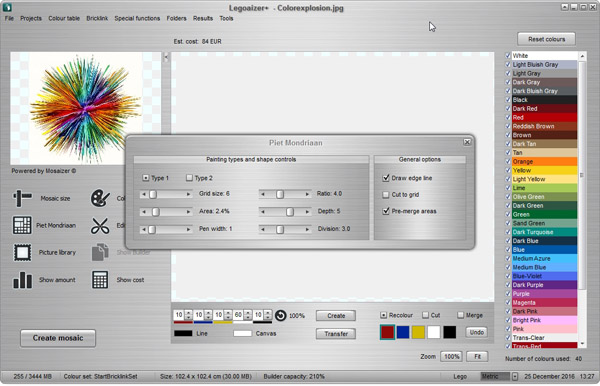
Type 2: horizontal and vertical lines are
created where some areas are merged, and lines are broken into parts. All
created at random.
